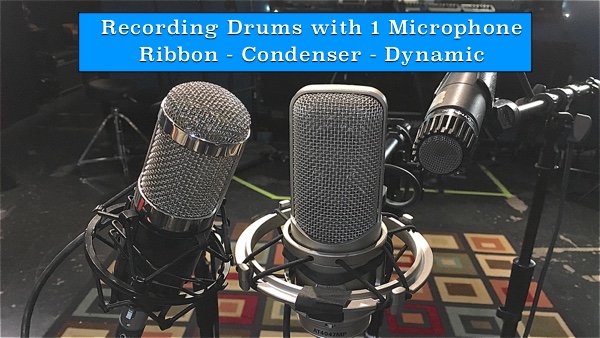The first step in your signal chain is the instrument, the next step is the player, and the third step is the microphone. It’s in this step that we can start to alter, or mold, our sound.
Although there are hundreds of mics on the market there are only really 3 basic types; Dynamic, Condenser, and Ribbons. There are also tube mics but in the video I’m only covering the 3 main types we use on a regular basis. The video is meant to give you a simple, side by side, demonstration of how the different mic types sound on drums. The mics are placed side by side about 5 feet in front of the kit.
I think you’ll get a good idea of how the 3 different mic types sound. The better you understand the differences the more you can take advantage of these mics to mold your sound.
Below is a bit more in-depth explanation of dynamic, condenser, and ribbon mics.
Happy recording!
Charlie
Dynamic Microphones
The dynamic is the most common and robust type of microphone. Popular examples include the Electro Voice RE20, the AKG D112, and the ubiquitous Shure SM-57. The durability, form factor, and inherent directionality of the dynamic make it ideal for live applications.
At the heart of every dynamic microphone is an electromagnetic coil attached to a diaphragm. Sound pressure hits the diaphragm, which moves the coil relative to a static magnet, producing a voltage. This configuration is inherently more directional and less sensitive than other types, making dynamic microphones ideal for close miking – especially of loud sources like drums and amplifiers.
Dynamic microphones are inherently cardioid or hypercardioid and most can handle even the loudest sources. Dynmanic microphones also tend to have narrower frequency response than other types (less low end and high end sensitivity). Some models designed for specific purposes (ie: kick drums) can have wildly nonlinear response curves.
Condenser Microphones
Condenser microphones offer greater sensitivity and wider frequency response than most dynamics. This is one reason they are favored as overhead microphones as well as hi-hats and rides cymbals. The increased sensitivity can make some condensers unsuitable for some high SPL applications like drums. Some condensers will feature a switchable pad to reduce sensitivity for high SPL situations but this may not always be adequate.
Condensers can also feature a variety of polar patterns, or may have multiple, switchable patterns. Often they will also feature a switchable high pass filter to eliminate unwanted lower frequencies. Common examples include the AKG 414, Shure SM81, and the Neumann U87.
A condenser element consists of a thin metallic diaphragm oriented parallel to a larger metal plate. When charged with an electric current, these two pieces act as a capacitor. As sound pressure moves the diaphragm, the capacitance fluctuates. This fluctuation creates a current that is converted to the output signal by circuitry within the microphone.
This circuitry and the need to charge the element require all condensers to be powered by either external phantom power or an internal battery. The wide frequency response, variety of polar patterns, and robustness of modern condenser microphones allows for an enormous variety of microphones to suit almost every application.
Ribbon Microphones
The oldest common microphone type is the ribbon. A thin metal strip – the “ribbon” – is suspended between two magnets. Sound pressure moves the ribbon through the magnetic field, creating a voltage between contacts at each end of the ribbon. This offers better high-end response than a dynamic element, but the design’s inherent figure eight pickup pattern limits their usefulness in situations where isolation or feedback is an issue. Many vintage ribbon microphones, such as the RCA 77, are highly prized for their smooth top end and robust bottom.
There are also many modern ribbon microphones, such as the Royer 122, that offer the classic ribbon sound while maintaining performance on par with other modern types. When connecting a ribbon microphone, be careful not to expose it to phantom power. Some older designs may be damaged by its presence. Most contemporary ribbon microphones have protection built in – some even have preamps requiring phantom power, but the safest option is always to keep ribbon microphones isolated from phantom power entirely.
For drums, the ribbon microphone’s figure eight pickup pattern limits its usefulness for most close-up applications. However, the smooth top end and full bottom of many ribbon microphones can be ideal for overheads and especially room miking.

